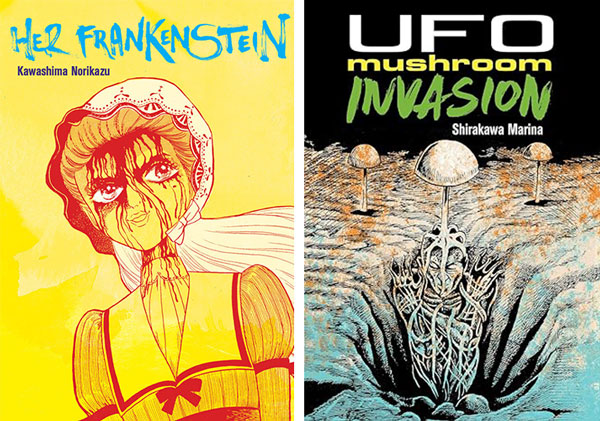By Shaenon K. Garrity
|
Smudge, a new imprint from boutique St. Paul, Minn.–based graphic novel publisher Living the Line, will introduce English-language readers to vintage pulp manga with a focus on horror, dark mystery, and the supernatural. Working with publisher Sean Michael Robinson, translator and editor Ryan Holmberg says he hopes to “excavate the best of that world from the past.”
“Horror manga is definitely having a moment,” says Zoe Hu, manager at Comix Experience in San Francisco, “and it’s expanded in ways I never expected.” The popularity of Junji Ito’s stylish contemporary horror manga has led to a surge of translations in the subgenre, including creepy classics by mangaka like Umezz Kazuo (Cat Eyed Boy), Miura Kentaro (Berserk), and Hirano Kouta (Hellsing). Hu finds that the dark side tends to draw crossover readers, too. Among her customers, horror fans are often more open to trying manga than other genre adherents.
Rather than compete for the latest hot contemporary series, Smudge is looking to acquire older manga with a cult following. The imprint launches this spring, with plans to publish two-to-three titles annually, focusing on originals from the 1950s to the 1980s. Robinson and Holmberg have tapped the staff at Mandarake, a Japanese chain of manga stores known for its selection of vintage titles, to help source potential licensees.
Robinson says he wants the imprint to “feel like a series, in the sense that someone knows what they’re getting into when they buy a book that has the Smudge logo on the spine,” but with an element of surprise and discovery. “Part of what they’re getting into is that they can’t quite picture the genre or artist they’re going to read” until they crack that spine, he says.
Smudge’s launch title, Her Frankenstein by Kawashima Norikazu, was originally published in 1986. PW’s starred review calls the English language debut “a stunning psycho-horror” that will appeal to fans of Emil Ferris’s My Favorite Thing Is Monsters. Coming later in summer is UFO Mushroom Invasion by Shirakawa Marina, which Holmberg says has a following in Japan as “probably one of the weirdest science-fiction horror manga.”
Robinson calls it outsider manga. “As far as I know,” he says, “there are no other books like it out there.”
Holmberg, who has a PhD in Japanese art and wrote his dissertation on the influential alternative manga magazine Garo, brings what Robinson calls an “editorial package.” Most manga translators in the U.S. have little control over the titles they get assigned, but Holmberg belongs to a small group of translator/scholars who handle translation, localization, editing, and supplementary materials like background essays and interviews. He’s also collaborated with literary comics publishers like Drawn & Quarterly.
“I only work on projects that I’m interested in,” Holmberg says, “and oftentimes that don’t necessarily have a large readership. In the case of Smudge, I’m trying to find a happy marriage between genre works that have a sustainable market and my interests as a historian.”
Robinson hopes the outsider vibe of Smudge will boost its appeal. “Ryan and I have talked about a dozen different titles by a dozen different artists I had never heard of before,” he says. “Shirakawa has his own mini Instagram cult of people who have gotten tattoos of images from his books, people who like them for their obscurity. It’s private, like a secret they have.”
Holmberg agrees. “The audience for niche and cult is less small than those words might suggest,” he says. Smudge, which will be distributed with the rest of Living the Line’s releases by Diamond, looks to prove it.
